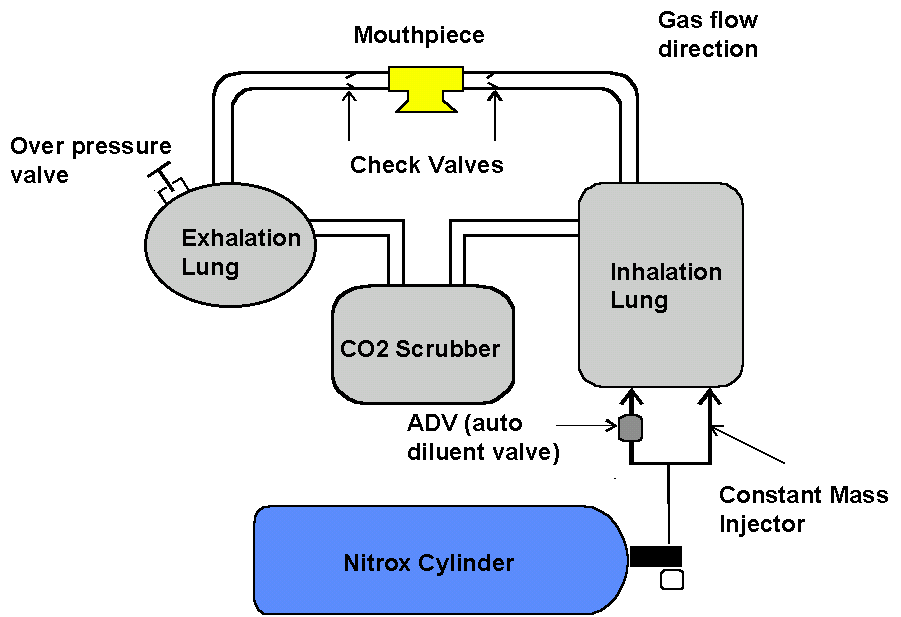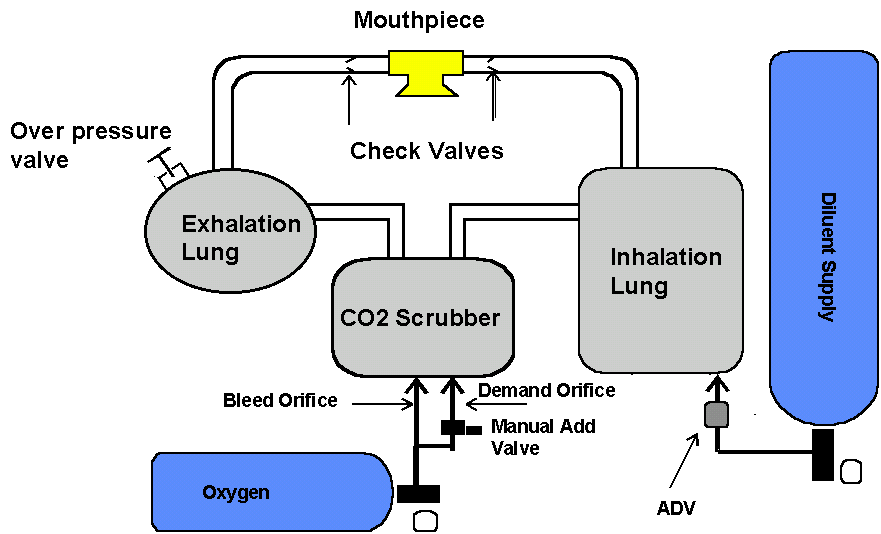KISS Rebreather diving aka DOCCR aka MCCR
What exactly is the KISS approach to rebreather
diving? Other than a brand name of a rebreather manufactured by Gordon
Smith of BC, Canada, it has been adopted as the mantra for the manual closed
circuit rebreather crowd. Simply put it is what the acronym stands for; Keep
It Simple
Stupid. As with any type of diving, it
is usually the simple direct approach which is the best. The other acronym
DOCCR and the abbreviation MCCR describe what a KISS rebreather is. DOCCR
(pronounced doccer) is a Dual
Orifice Closed Circuit Rebreather which describes how I use a second orifice to
control the flow rate of the manual O2 addition to a manual closed circuit
rebreather (MCCR).
We start with the block diagram of a semi-closed
circuit rebreather as shown on your right. The exhaust bag is optional. The
gas supply is usually nitrox. Without adding gas to the system the oxygen
content drops with each breath as you metabolize the oxygen in your body.
One would become hypoxic quickly if a source of oxygen is not added. To
counter this there is a constant stream of nitrox added to the loop. This
amount is somewhat less than open circuit. The oxygen enriched air is
continually added at a constant mass to make up the oxygen metabolized i.e. so
many liters per minute. We are consuming only part of the excess oxygen added and none of the
nitrogen. The excess is passed out of the system as small bubbles thru the
exhaust valve. The carbon dioxide is removed in the scrubber before passing
to the inhalation bag and the diver for rebreathing. You will also see a ADV (Auto Diluent
Valve) which is a fancy word for a demand regulator or second stage. Its
purpose is to add gas as the diver descends and the counter lungs collapse.
(Boyle's law)
|

|
|
. Remember I said the gas is
always nitrox? If it was air, the oxygen in the system would be too low to
sustain metabolism. It is particularly critical whilst the diver is
shallow. The resulting PO2 will be too low when the diver is shallow. When we breath air at 21%
we exhale approximately 16 % O2 and 5% CO2 (carbon dioxide). Of course the
CO2 is removed by the scrubber. If we didn't
replace the O2 we would be below 10% oxygen after rebreathing the same air several
times because we are metabolizing it. In fact under stress or
strong exercise, fractional loop FiO2 (inspired O2 percentage) can be
as much as 15% below FsO2 (supply O2 percentage).
There
are two basic types of semi-closed rebreathers; active and passive. In the
active systems, nitrox is added at a constant mass i.e. number of molecules per
minute usually measured in liters per minute. The constant mass injector
is usually a sonic orifice but can also be a flow restriction valve.
Various flows are pre-selected before a dive based on depth and supply gas
used. The efficiency of an active SCR is about 5
to 1 over open circuit. In a passive system, nitrox is added as a function
of the RMV (respiratory minute volume) of the diver. In deep diving using trimix, the efficiency
of a passive system is better than 15 to 1 over open circuit. They have an
advantage over an active SCR in that if you run out of gas you can't breath just
like in open circuit. They
are however more complicated. |
|
A simple closed circuit rebreather is
shown next. The design is along the lines of the KISS rebreather. It has many similarities to a semi-closed system except we do
not have to add nitrox continuously to the breathing loop. In fact we only
add small amounts of oxygen to exactly match the amount of oxygen our bodies metabolize. The
diluent mix can be air, nitrox or trimix. It is
needed to dilute the oxygen and to fill the counter lungs as the diver descends.
(Boyle's Law). As only the amount of oxygen the diver metabolizes is
added, there is no build up of excess gas in the
loop. The advantage here is that gas efficiency jumps very high and there
are no bubbles except when ascending from depth. The ADV as mentioned
above activates when the diver descends and is the only time diluent gas is
added to the
loop. |

|
There are some real draw
backs to this type of rebreather. The diver has to always know the PO2 in the
loop as he/she is the one who will be adding the O2. This is usually accomplished by using
multiple PO2 gauges (fancy waterproof
oxygen analyzers). The
diver is the one making the thumb brain connection and the decision as to when and
how much oxygen to add to the loop. This does add to the task loading of
the diver. The diver also has
to be in tune with his/her body's metabolic needs under various conditions. There are two types of closed circuit rebreathers,
Manual (MCCR) and
electronic (ECCR). The difference is that in the electronic system the diver has
to do little and all the oxygen and diluent additions are done by onboard
computers. The problem here is that if something fails, things can turn bad
quickly.
Dave Thompson, the original designer of the Buddy Inspiration ECCR, put it very
well. He said; "The bad thing about manual CCR's is you
"need" to drive them, and to a degree that's task loading...
The good thing is you KNOW that if you don't, you will die. It focuses the mind.
The good thing about electronic CCR's is you don't need to do anything
because they drive themselves. The bad thing about electronic CCR's is they
MIGHT go wrong, and you MIGHT not notice it because you don't need to do
anything right!!!!"
I couldn't agree more. Most of the bad press in
rebreather diving has been caused by experienced open circuit divers trying to do the same
dives they are accustomed to doing on open circuit with a rebreather but without a rebreather
mindset. Yes, there is definitely a different mindset for rebreather
diving that has no correlation to open circuit. For example, if you run
out of gas, you can keep breathing until you die due to hypoxia (lack of
Oxygen). Even technical divers, as
disciplined as they may be, must start all over when adopting rebreathers for
their diving equipment. A well known rebreather diver and fish guru, Richard
Pyle remarked on the learning curve in rebreather diving: "After my
first 10 hours on a rebreather, I was a real expert. Another 40 hours of dive
time later, I considered myself a novice. When I had completed about 100 hours
of rebreather diving, I realized I was only just a beginner."
Rebreathers are great pieces of equipment that predate open circuit by more than
75 years. They require a great deal of attention as opposed to open
circuit gear. The key to rebreather survival is discipline, discipline,
discipline. Otherwise they become very
unfriendly fast. Murphy loves the undisciplined rebreather diver best of
all. You can be guaranteed that the only time you may omit one step in the pre-dive checks, he will be
there.
If you are contemplating either modifying a generic rebreather to closed
circuit use or you are trying to design one on your own be forewarned. The
fact is that rebreathers, especially closed circuit rebreathers, can aid in your
demise. The rebreather doesn't kill, but complacency does. Reflect back on
Richard Pyle's words of wisdom. Then, always know your PO2. Always
know your PO2. Always know your PO2. Whether SCR, ECCR or MCCR,
always know your PO2. Do you get the hint? If you don't, do not
undertake rebreather diving. We have lost a lot of good and very
experienced divers to complacency, don't become one of them.
BACK

